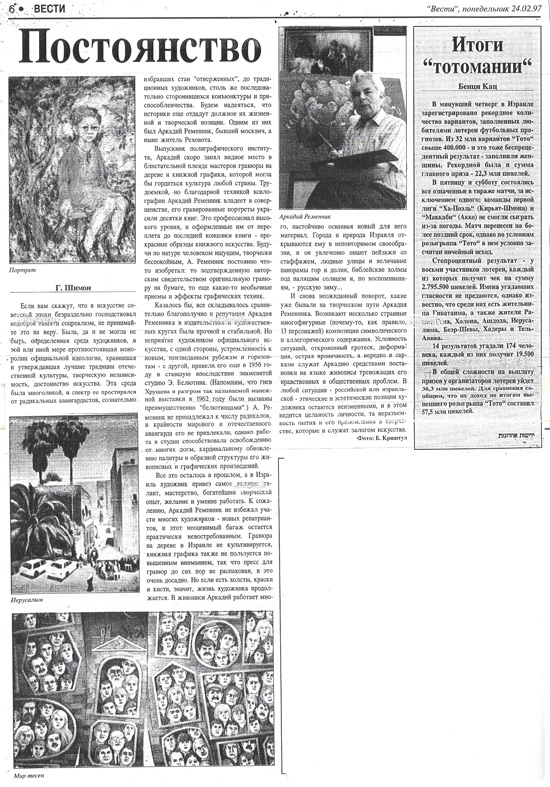English translation below.
Click for LARGE version (PDF):
Newspaper “Vesty” 24.02.1997
PERSISTENCE
G. Shimon
They say the socialist realism, which left a sad memory, reigned supreme in the art of the Soviet epoch. But don’t take it for granted. There was, and it couldn’t be otherwise, a certain artist’s environment, which, in some way, contradicted the monopoly of the official ideology, preserved and enrooted the best traditions of national culture, creative independence and dignity of art. That environment was multifaced; its spectrum spread from radical avant-gardists, who deliberately chose the camp of pariahs, to traditional artists, who consistently avoided an official outlook and time-serving. Let’s hope that historians will do justice to their civil and creative viewpoint. Arkady Remennik, a former Moscowite and a present resident of Rehovot, was one of them.
Arkady, a graduate from the University of Poligraphy, shortly took an outstanding place in a brilliant pleiad of leading artists specialized in engraving upon wood and book graphic illustration, a culture of any country would be proud of. Arkady Remennik obtains to perfection a labor-intensive but significant technology of xylography; his engraved portraits decorated dozens of books. He is a high level professional, and the books decorated by him from a cover to the last page are brilliant samples of book illustration art. Being a creative person by nature A. Remennik was in a constant striving for inventing something: original engraving upon paper approved by certificate of authorship and unusual techniques of graphic art.
Things seemed to be going in the right direction, and reputation Arkady Remennik had in publishing houses and art cycles was strong and stable. But his antagonism to the official art on the one hand and striving for new, unknown frontiers on the other hand led him in 1956 to the studio of E. Belutin, which became well-known later. (Let me remind you of the fact that Khrushchev’s rage and crackdown of the so-called Manezh exhibition were mostly caused by the “Belutin’s followers”). A. Remennik has not been among radicals; extremes of the world and national avant-garde didn’t attract him, but his work in the studio aggravated his getting rid of many dogmas and cardinal refreshing of graphic pallet and image-structure of his art and graphic works.
Everything remained in the past; the artist brought the most valuable to Israel: his talent, skills, a rich creative experience, wish and ability to work. Unfortunately, Arkady Remennik didn’t escape the fate of many artists – new immigrants, and this priceless mental equipment is still non-demanded in reality. Engraving upon paper is not accepted in Israel; neither book illustration graphic is very popular here. That’s why the graving press is still packed – and this is very regretful. But an artist’s life continues, if he has canvases, paints and brushes. Arkady works a lot absorbing new environment. He perceives cities and nature of Israel in an exceptional variety, and he absorbedly paints landscapes with staffage, crowded streets and majestic panoramas of mountains and valleys, Biblical hills in a scalding sun and the Russian winter from memory…
And again – a sudden turn Arkady Remennik used to take during his creative development. Extraordinary compositions of symbolic and allegoric content with a number of figures (13 characters as a rule for some reason) appear. Conventional situations, pure grotesque, deformation, acute irony, and, frequently, sarcasm – are art techniques Arkady uses to bring forth problems of public and moral character he concerns about. In any kind of situation, either Russian or Israeli, ethical and aesthetical artist’s positions remain unchanged; that is the basis of the integrity of his personality and nonseparability of entity and its deflection in the artist’s creative work, which serves as a pledge of art.
|
||||||||||||||||







